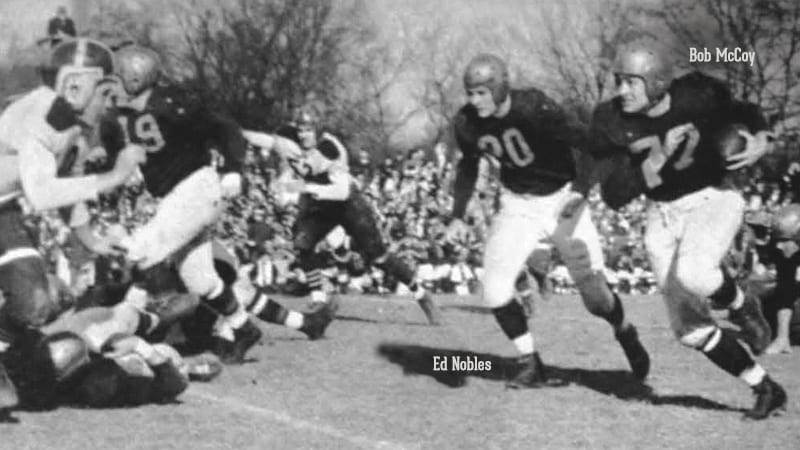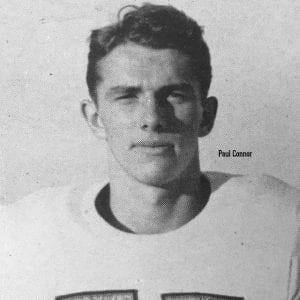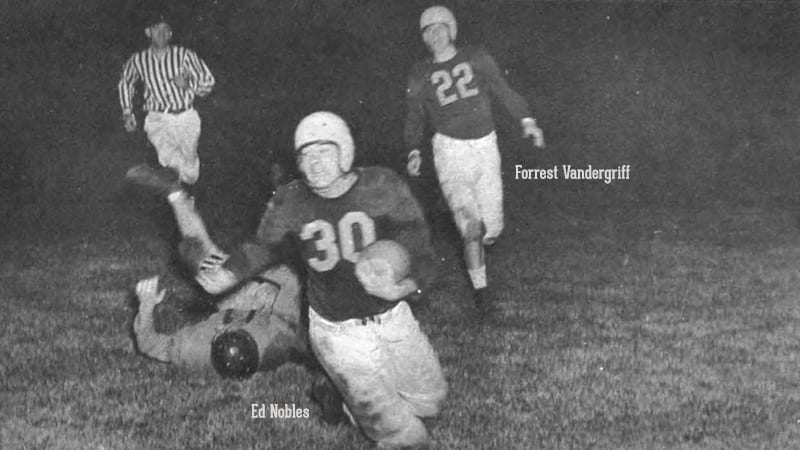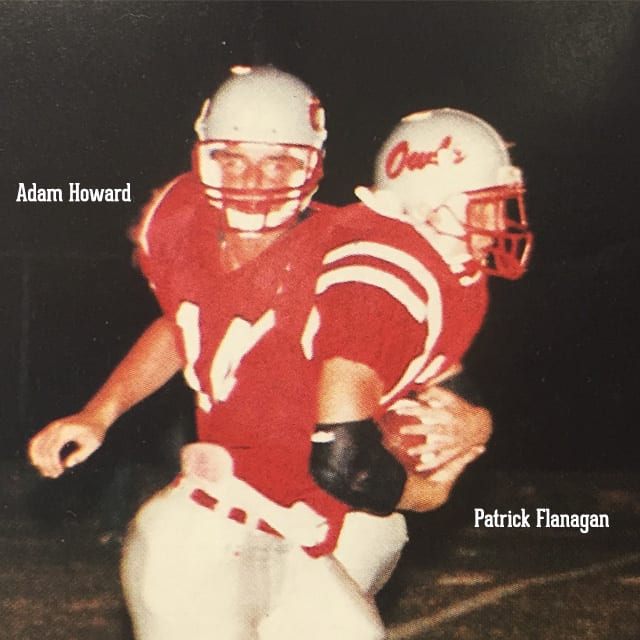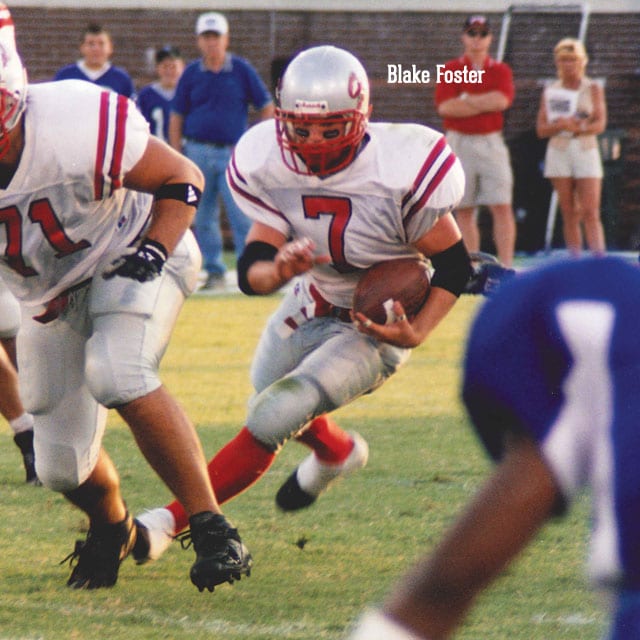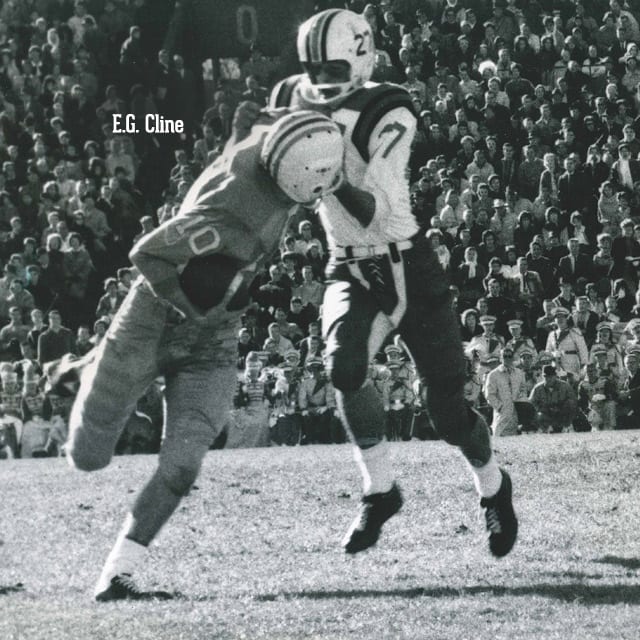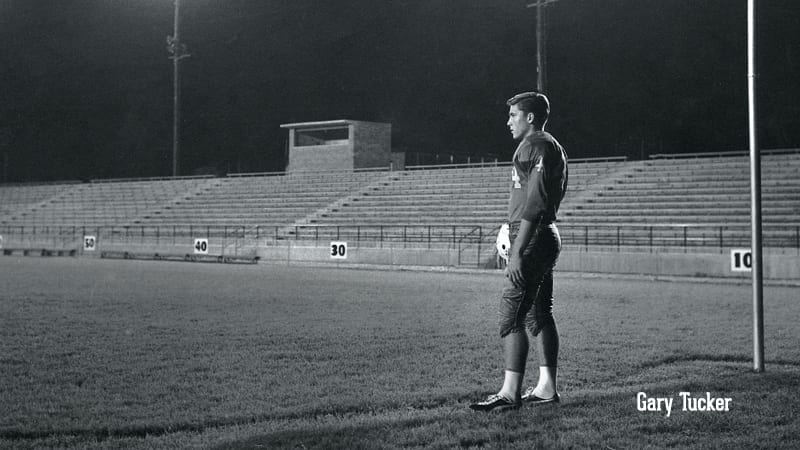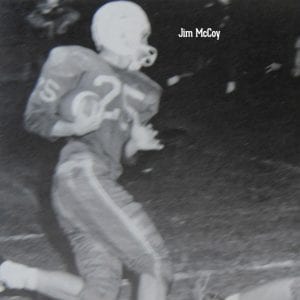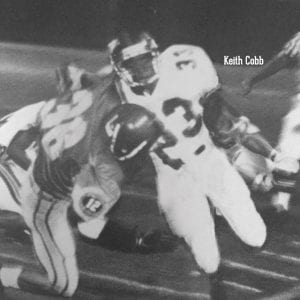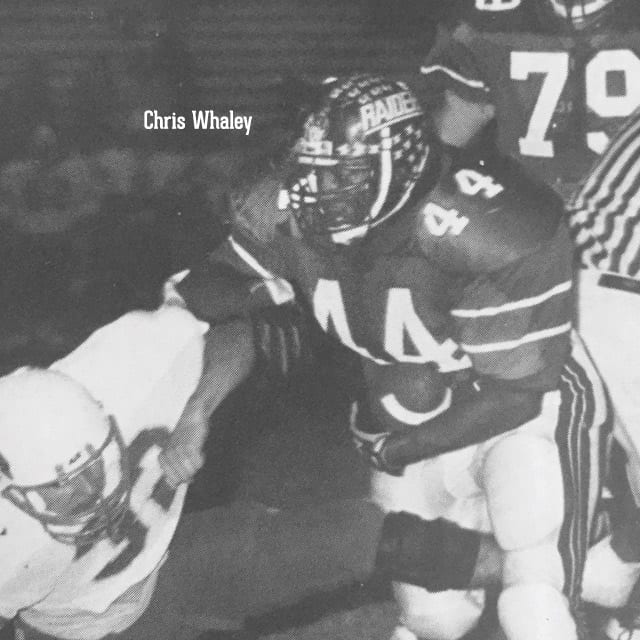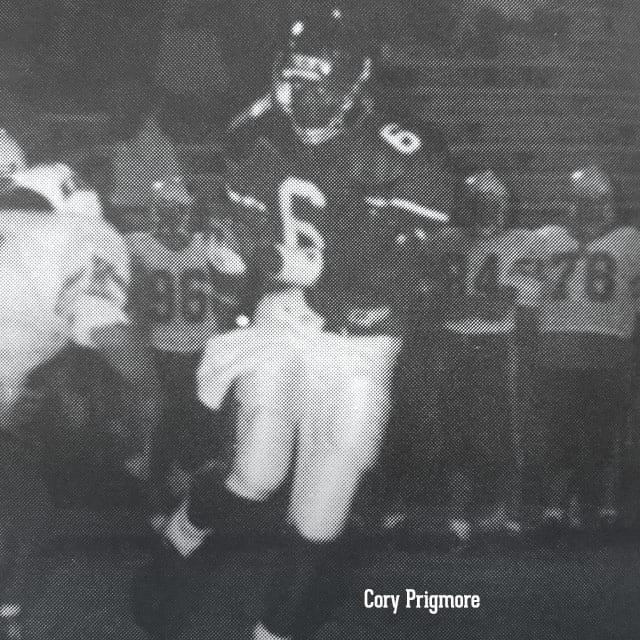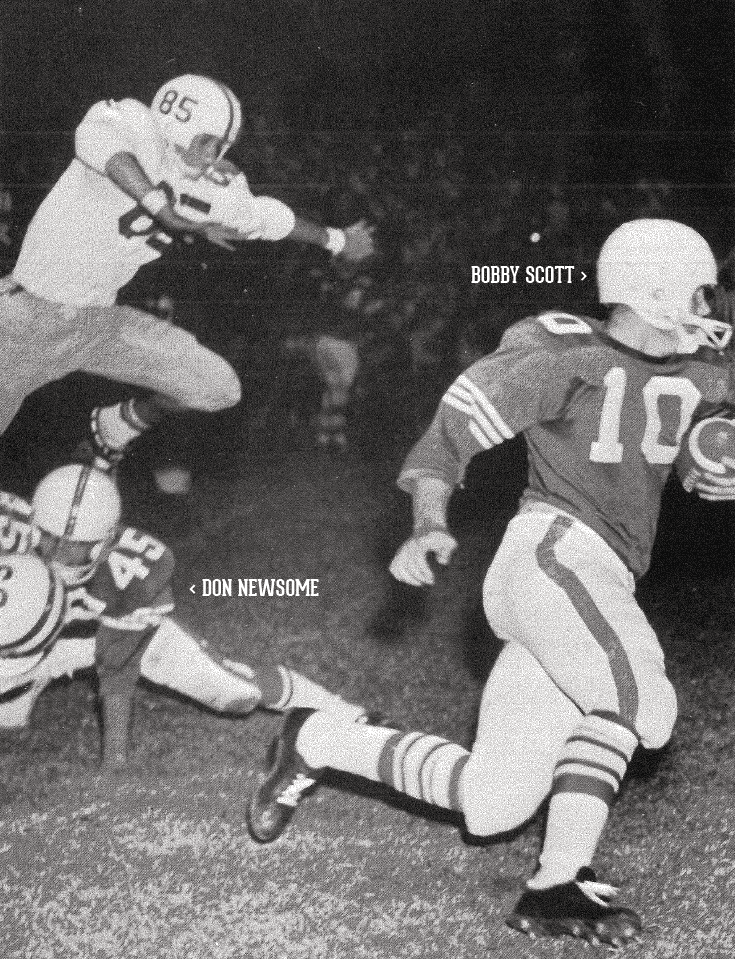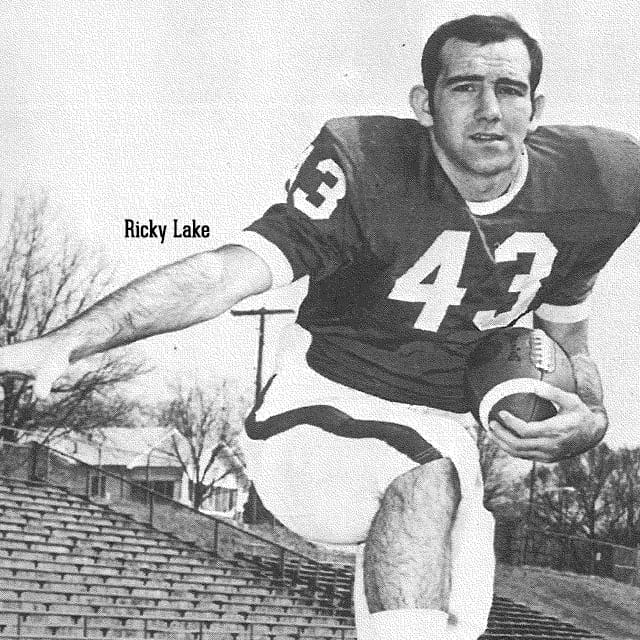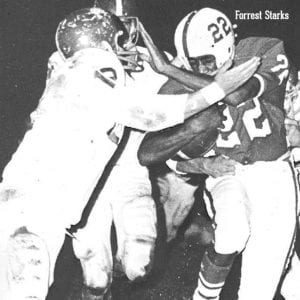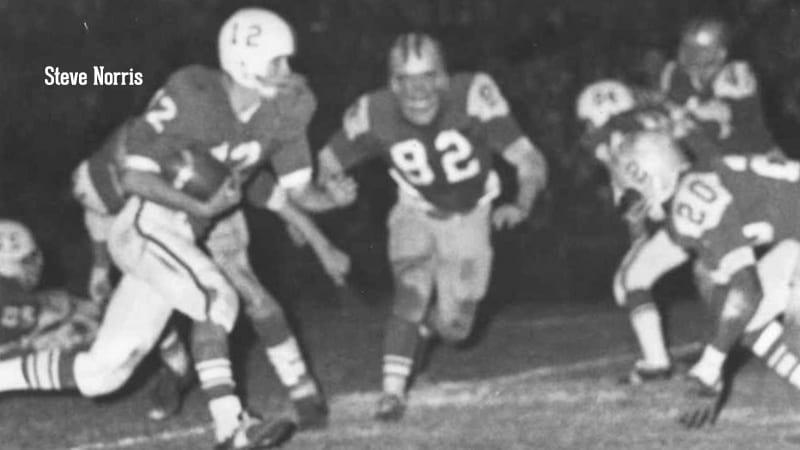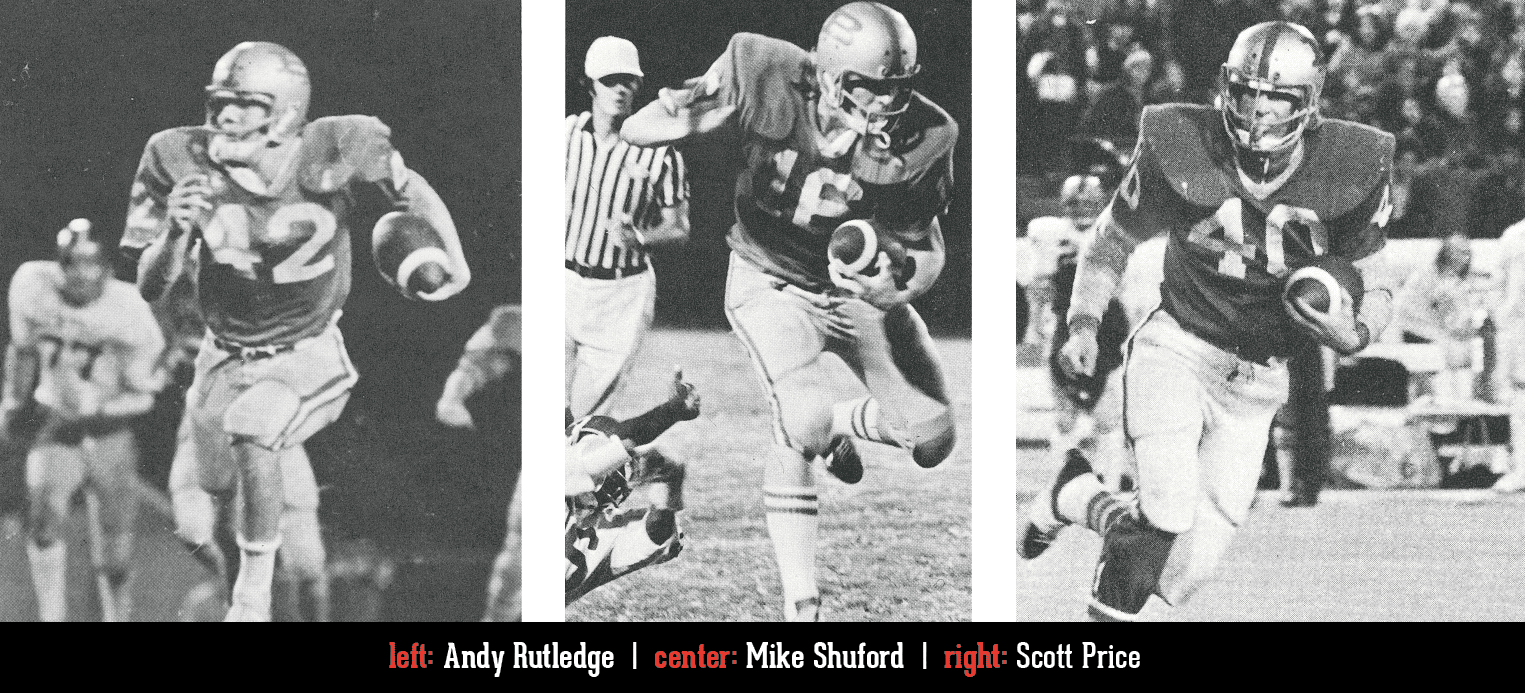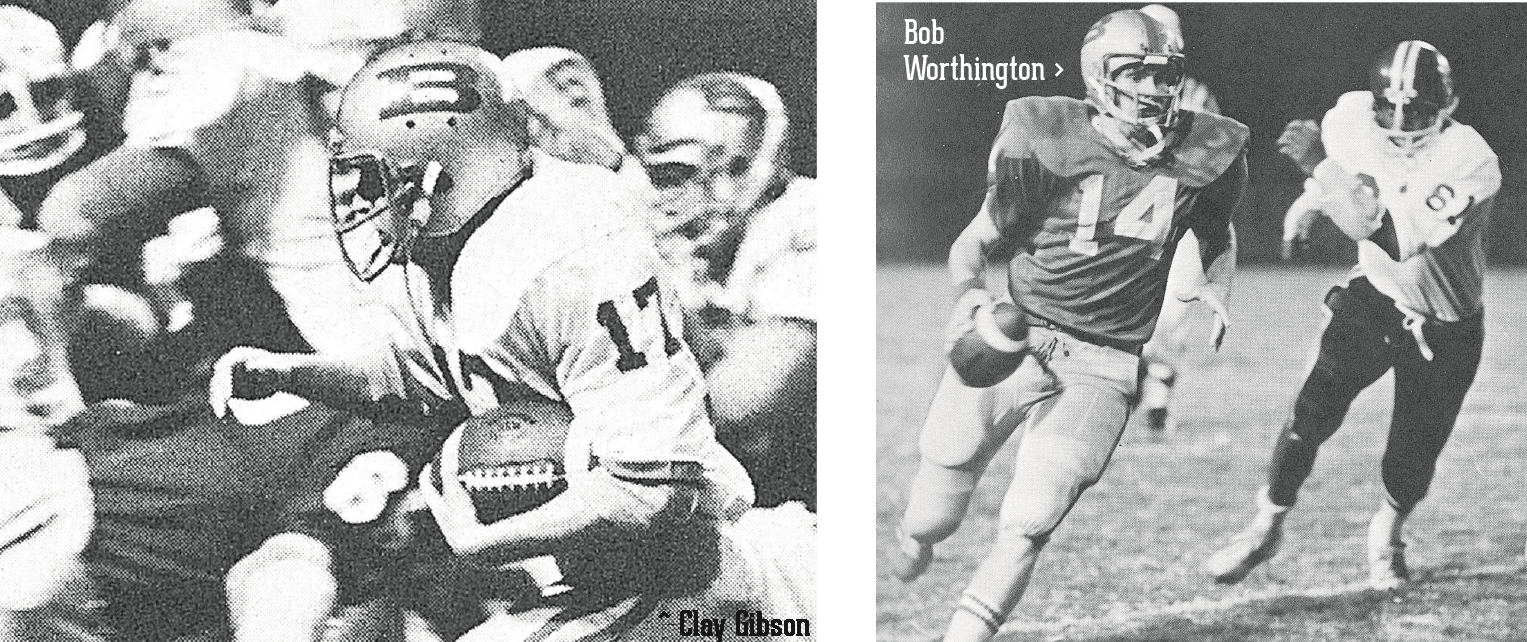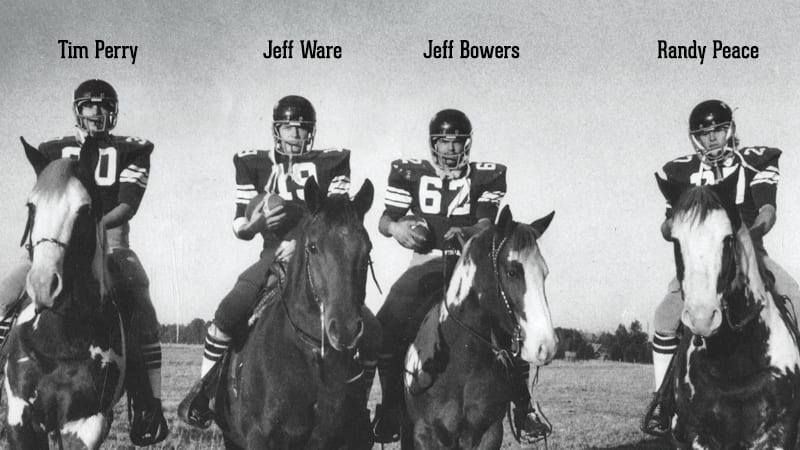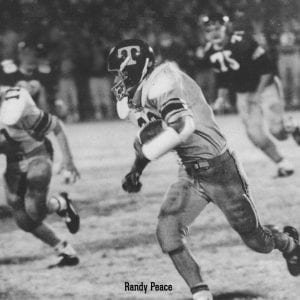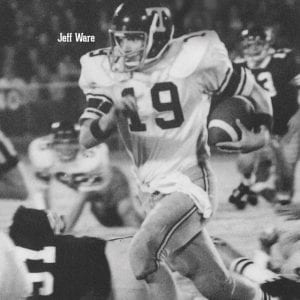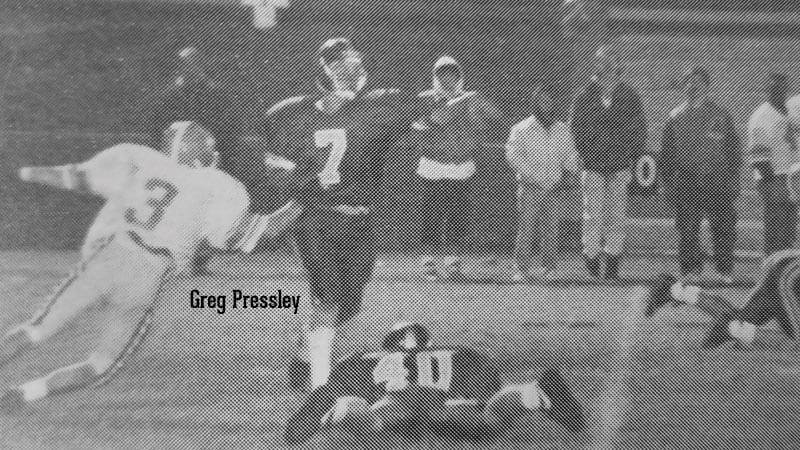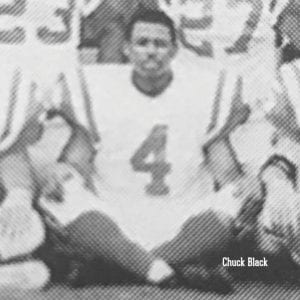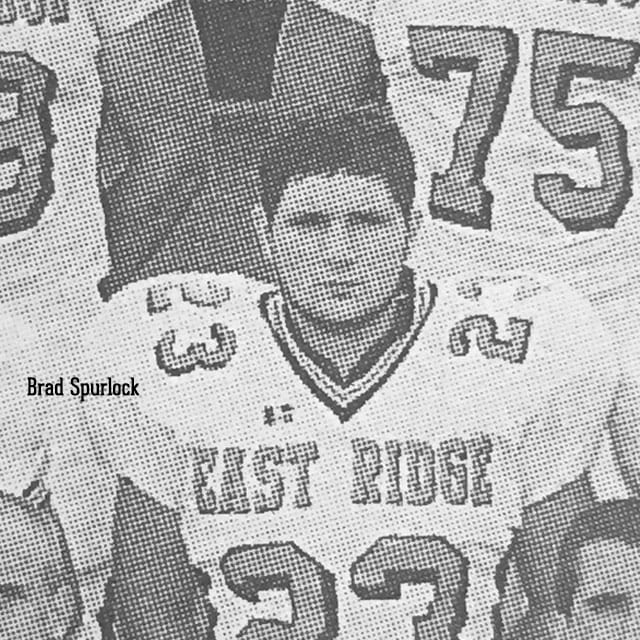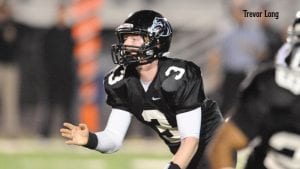The greatest backfield units to ever grace the field
By Julia Sharp
Even in an area like Chattanooga where high school running backs and quarterbacks are known to compete at a high level, the top individual performers tend to stand out among the rest. However, more often than not, it’s the collective force of three or four players in the backfield that can truly dictate the outcome of a game. Here, we take a look at some of the best backfield players to ever take the field – as a unit.
Under head coach E.B. “Red” Etter’s leadership, the Central Purple Pounders were crowned state champions in the Litkenhous Poll in 1946, which brought the school its first state title. Etter played to the strength of his backfield – led by halfbacks Ed Nobles and Bob McCoy, fullback Forrest Vandergriff, and quarterback Paul Connor – by implementing his legendary T-formation offense. The 1946 Pounders were one of the first teams in the Chattanooga area to use this scheme, and Etter had the personnel to set the tone for years to come. The Pounders offense put up over 400 points in 1946 – the first team in their league to ever exceed the 400-mark.
At the helm of the offense was team captain and starting quarterback Paul Connor. Gene Etter, coach Etter’s son and Baylor’s recently-retired head baseball coach, remembers his father saying that Connor was an exceptional passing quarterback, bringing balance to Central’s run-heavy offense. “In the 1946 season, during a time when running the football was the primary focus of high school offenses, Connor threw for seven touchdowns,” Etter says. “That was an exceptional number at that time.”
The ground game featured halfbacks Ed Nobles and Bob McCoy. Both were seniors, and together they brought a one-two punch that relentlessly demoralized opposing defenses. It didn’t hurt that Bill Meadows, an outstanding guard who earned All-City honors in 1946, and Forrest Vandergriff, the starting fullback, were opening up holes in the defensive line for them.
On the left side of the “T” was Nobles. Dubbed “Racehorse” for his quickness, he was the team’s second-leading scorer in 1946 with 19 total touchdowns. His prolific career at Central, where he was All-State in 1945 and 1946, earned him a football scholarship to the University of Chattanooga (now UTC).
At the right halfback position was Bob “The Wauhatchie Express” McCoy. “Dad told me the reason he put left-handed McCoy on the right was very intentional,” Etter says. “This enabled him to fake a sweep to the left and be in a natural position to throw a pass.” In his career at Central, McCoy was named All-State in three consecutive seasons. In 1946, he led the Pounders in scoring with an all-time league record of 150 points. McCoy continued his football career at Georgia Tech, earning All-SEC honors and holding the school record for longest touchdown from scrimmage (87 yards) for 60 years. In 1951, he was drafted by the NFL’s Los Angeles Rams.
A Great Rivalry, But No Contest –
The 1946 City vs. Central grudge match was tough for City fans. Nobles and McCoy combined for nine touchdowns, leading the Pounders to an 81-6 win. This blow was one of the worst defeats in a City
Prep League game at that time.
The 1952 Pounder backfield was led by senior quarterback Jimmy Pack. The running back situation was a three-headed monster. Junior back Bobby Hoppe, who would later be widely recognized as one of the best backs to set foot on a high school football field in the Chattanooga area, was accompanied by senior halfbacks Tommy Tillman and Bill Hale. It was the perfect personnel situation for coach E.B. “Red” Etter’s T-formation scheme.
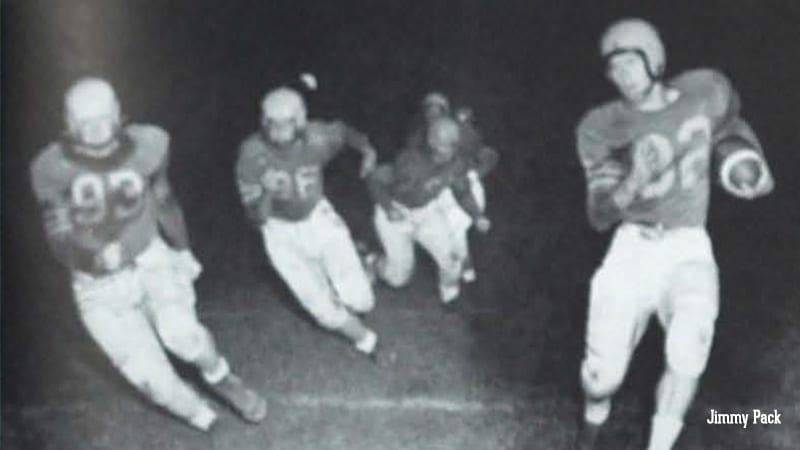
Central outscored their opponents 261 to 80 in 1952. Of the 261 points, 126 of them came from running backs Bill Hale and Tommy “Terrible Tommy” Tillman.
Bobby Hoppe, nicknamed by sportswriters “The Rabbit” and “Hippity Hoppe” for his speed and fitting last name, was the only junior in the backfield that season. He played fullback and led the team with 18 touchdowns. When asked what made Hoppe such a rare talent, Etter points to his blend of power and speed. “It seemed as though he was the only player out there without the weight of the pads on him. He’d make a slight movement, make someone miss, a hole would open up, and then he’d be gone,” he says. Etter adds that by the time Hoppe was in the end zone, no one was within 15 yards of him. Hoppe went on to play at Auburn where he won a national championship in 1957 and played professionally with the San Francisco 49ers and the Washington Redskins.
The 1952 Purple Pounders’ season ended with an AP-voted state championship. It was the program’s third state championship in seven years.
The first return reverse in Central’s history?
In 1953, Hoppe’s senior season, head coach E.B. Etter called a play he had never used before. During the Kiwanis Charity Bowl in Miami’s Orange Bowl Stadium, Miami Senior scored a late touchdown to tie the game. On the ensuing kick-off, Central’s deep back, Robert Tate, fielded the kick then ran up-field and to the right, where Hoppe took a handoff, reversed field, and ran for an 89-yard game-winning touchdown. This play ended the game and solidified another Central state championship.
After starting the season with three consecutive losses in 2001, Ooltewah turned the season around and ended up playing in the Class 5A state semifinals. The success of the season is largely attributed to quarterback Adam Howard and running backs Patrick Flanagan, Blake Foster, and Zach Sanders.
“Even when they were in middle school, you could tell they were special. They honed their craft, went above and beyond during practice, and still worked incessantly hard in the off-season,” remembers Ted Gatewood, who was the head coach at wah at the time. “They were all great athletes, but their strong suit was their maturity, unselfishness, and care for each other. They played as a team, not as individuals,” adds former backfield coach Al Rogers.
2001 All-State quarterback Adam Howard was a drop back passer with an accurate arm and a firm understanding of the game. “Adam was the general on the field. He had great vision, and he never panicked in the pocket. He listened well and just had a maturity about him that you don’t see at that age,” Rogers says.
Howard’s ability to stretch the field opened up the running game for a prolific back. “Usually you have running backs who either try to make you miss, or they run over you,” Rogers says. “Patrick Flanagan was capable of doing both.” Rogers adds that his vision and ability to churn out extra yards was exceptional. “He was very intelligent. He would always get one or two extra yards when you thought there was nothing left to get.” Flanagan finished the 2001 season with All-State honors, and he owned the Chattanooga area career rushing record with 5,377 yards.
Gatewood adds, “Successful tailbacks like Flanagan also have a very good fullback to block for them.” All-State fullback Zach Sanders was exactly that. Rogers describes him as unselfish and unwavering. “If I was to describe Zach in one word, it would be ‘a bull,’” he says. “Zach was a bull in a good way, stubborn in a good way. He would not back down from a challenge. He was a great blocking back. Zach would just give you every ounce he had.” Gatewood notes that Ooltewah’s offensive line was also critical in establishing the run game.
Rogers is quick to mention that another running back who deserves recognition is Blake Foster. “He was a junior in 2001, and he was a fantastic back who started when Patrick got injured,” Gatewood says. As a starter in 2002, Foster earned All-State honors after helping lead Ooltewah to the playoffs. His depth-adding presence in 2001 didn’t go unnoticed.
Gatewood and Rogers agreed that there were too many outstanding moments to choose just one. “To those four guys, exceptional was the norm,” Rogers says.
In 1960, the Brainerd Rebels were the new kids on the block as a brand new Chattanooga area school. In 1961, the Rebels played their first full varsity schedule. The city of Chattanooga would see them go undefeated and head into the 1962 season as a powerhouse driven by a prolific backfield featuring quarterback E.G. Cline and running backs Gary Tucker, Jim McCoy, Jim Verhey, Larry Reese, and Wesley Puckett.
Head coach Ray Coleman and running backs coach Pete Potter molded a ground-driven team that ran an option-based offense, taking advantage of a sizable offensive line led by All-City end Dr. DeWayne McCamish and All-State tackle Jim Clark. Steve Goldsmith, who also anchored the offensive line at the time, remembers All-City quarterback E.G. Cline as a perfect fit in that offense. “Even though he wasn’t a big guy in stature, everyone felt absolutely confident in his ability to lead our team down the field,” he says. McCamish adds, “E.G. could do it all, which is what made him so effective. On top of that, he made the right decisions at the right times.”
Standing at 5’10” and 190 pounds was Gary Tucker, the bell cow back for the 1962 Rebels. With thighs like tree trunks and quick-cutting ability, Tucker had the elusive and highly sought-after combination of power and speed. “Gary carried the mail; he was the workhorse in our offensive scheme,” says McCamish. Goldsmith vividly remembers the lopsided one-on-one drills in practice. “Gary flattened the players trying to tackle him more times than they were able to tackle him,” he says. “His knees came up like pistons, and he had incredible lower body strength.” Tucker led the state of Tennessee in scoring in 1962 with 150 points and was named All-State for his efforts. He went on to play at Vanderbilt then UTC (formerly UC), and he was drafted by the Miami Dolphins in the fifth round of the 1967 draft.
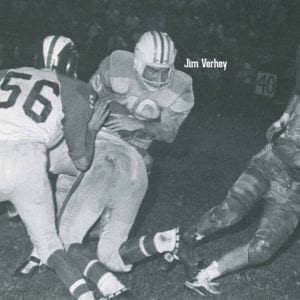
Additional running backs McCoy, Verhey, Reese, and Puckett all played a hand in the team’s success and took turns carrying the load. When asked what made this year special, both McCamish and Goldsmith agreed that it was the unique combination of individuals who supported each other on and off the field. “You had this feeling that you were more or less invincible if you did the right thing, put in the physical work, and just mentally refused to lose. That’s the way I felt then, and that’s how I feel today,” Goldsmith says. “Not just because of football, but because of the team and the way we thought. We carried this aura about us that no one could defeat our team, because each player refused to quit, even for a single down.”

Brainerd finished undefeated again in 1962, with two players receiving All-State honors and another five named to the All-City team.
On September 3, 1993, Cleveland thumped Hixson 70-3 to kick off what would become an undefeated, state-championship-winning season under head coach Benny Monroe. Operating out of the Wing-T, quarterback Cory Prigmore managed an offense that produced three 1,000-plus-yard rushers in a single season. “You’ll hardly ever see three backs in the same backfield each gain over 1,000 yards in one season,” says Monroe. “Those guys expected to win when they went out there on Friday nights.”

All-State running backs Keith and Kevin Cobb were twin brothers. “Very conveniently, Keith was left-handed and Kevin was right-handed, so Keith played right halfback, because he ran to the left most of the time, and vice versa,” remembers Monroe. “One of them ran the 40-yard dash in 4.33 seconds, and the other ran it in 4.36 seconds, which is just phenomenal,” Monroe says. “When either one of them broke free, the announcer would say, ‘He’s gone!’ That’s just how it was.” The Cobb brothers continued their football careers at Memphis.
At 240 pounds, Whaley was Cleveland’s workhorse who plowed between the tackles. “Chris was just a bull,” says Monroe. “He ran our mid-line plays early and often to establish an inside game and open up the perimeter for the Cobb boys.” Whaley was also an outstanding receiver and caught the ball out of the backfield, a rare trait for a fullback, including a pass for 70 yards in the 1993 Class 4A state championship.
Because Cleveland ran the ball so effectively, quarterback Cory Prigmore didn’t get a chance to fully prove himself as a passer during the regular season. However, in the Class 4A state title game, Brentwood Academy’s run defense forced his hand. “In general, Cory ran the show and was really good technically, but we didn’t throw a whole lot,” remarks Monroe. “That day, though, he was the Offensive MVP. He completed 12 of 18 passes for over 160 yards. It surprised some folks that we could throw the ball, but the fact of the matter was that we just didn’t have to until then.” His performance locked up the Class 4A state championship and a perfect season for the Blue Raiders.
They didn’t know it at the time, but this backfield, along with a stout defense, kicked off one of the greatest streaks in Chattanooga’s football history. The Cleveland Blue Raiders won 54 consecutive games and reigned as state champions for three straight years (1993, 1994, and 1995). “That was a pretty special stretch of time,” Monroe adds.
Beyond the Run
With a minute left in the Class 4A state championship game, Prigmore connected on a pass to Keith Cobb to put the Blue Raiders on top for good with a final score of 26-21 over Brentwood Academy.
In 1988, Rossville High School became a part of today’s Ridgeland High School, concluding a 56-year run as one of the greatest high school football programs the state of Georgia has ever seen. While the program no longer exists, the Rossville Bulldog passion lives on today.
Legendary coach Lynn Murdock was in his second year as a head coach at Rossville when he had the opportunity to wreak havoc on opposing defenses with a scheme that was led by All-State quarterback Bobby Scott, All-State running back Rick Buff, wingback Don Newsome, and fullback Eugene O’Kelly. Buff remembers the team fondly and says, “Everyone had been playing together since the seventh grade, so we each knew what the other would do.”
Scott was tremendous on the ground, but he also had a natural ability to drop back in the pocket and throw. Buff remembers his teammate and laughs, “If Bobby threw you the ball, you either caught it or it stuck in you. He threw it like you were a dart board.” In addition to Scott’s athleticism, he had an incredible knowledge of the game and executed even the nuances at a high level as a result. “Because Bobby was such a great handler of the ball, the defense never really knew who had it until it was too late,” remarks Buff. Scott went on to do even greater things at Tennessee, where he currently ranks 10th all-time in career passing yards, and spent 14 years playing professionally – 12 in the NFL and two in the USFL.
Buff’s history of dominance at Rossville puts him on the map as one of the best Bulldogs of all time. “Rick Buff was the workhorse in 1965,” recalls Murdock. “He went over 1,000 yards in 10 games even though the ball was shared quite a bit – he only carried it around 100 times over the course of the season. He was very strong, especially in the legs.” Buff also led the team in scoring that season with 130 points. However, the tailback is quick to point out that he had some help up front, saying, “Our offensive line was just awesome. Most of the time, I’d go through the hole and nobody would even touch me.”
Newsome and O’Kelly were the perfect backs to complement Buff’s lead role. Newsome was only 5’6” and 140 pounds. “He was one of the toughest, quickest wingbacks you’ve ever seen,” Buff says. He adds, “Eugene O’Kelly was about 5’8” and 195 pounds. He was built like a bowling ball, and you couldn’t really stop him.”
That season, the Bulldogs finished 9-1, rushing for over 2,500 yards and throwing for over 700. Murdock recalls that the team also scored 269 total points, while Rossville’s combined opponents only scored 64. “That’s pretty outstanding,” he adds.
A Rivalry for the Ages
Rossville and Dalton held one of the most heated rivalries in Georgia history. In 1965, Rossville defeated Dalton 20-17 when Buff scored the winning touchdown on a 75-yard rush in the final minutes. More than 11,000 people attended.
The 1967 Dalton team was loaded with an All-State quarterback in Steve Norris and a three-headed rushing monster – All-State running backs Forrest Starks, Ricky Lake, and Keith Whitworth. Led by head coach Bill Chappell, the team set the state championship as their goal from week one, and they brought it home. Dalton football historian and current announcer Randal Davidson says the group was exceptional. “Dalton has always been a small town in Northwest Georgia producing football teams playing above their abilities,” he notes. “This team was special in that it’s the one that was finally able to break through and win it all.”
Freshman stud Keith Whitworth played tailback and led the team in rushing with 907 yards. Whitworth shined in a number of games, most notably against Ringgold when he had nine carries for 145 yards and three touchdowns.
Junior back Forrest Starks rushed for 777 yards and 14 touchdowns. Starks’ standout play came during the game against Rossville, which Davidson says was a powerhouse and longtime rival. Starks rushed for 149 yards and three touchdowns on 12 carries, playing a key role in the 44-0 rout of the Bulldogs. “It was the largest loss in the history of the Dalton versus Rossville series,” Davidson remarks.
Junior Ricky Lake rushed for 706 yards as a fullback. During the game against North Whitfield, Lake only had six carries, but three of those were for 89, 60, and 58 yards. He finished the game with 215 yards in the 57-0 shutout.
The only senior in the backfield was quarterback Steve Norris. According to Davidson, Norris truly had a knack for getting the ball across the goal line from short range on the ground. Although Dalton didn’t throw much, Norris efficiently passed for 550 yards and 10 touchdowns. “In a four-game stretch, Norris completed 17 of 21 passes with six touchdowns,” Davidson says.
Dalton had opened their season with a 7-6 loss at the hands of West Rome, which motivated the Catamounts throughout the year. That loss was redeemed when the Catamounts beat that same team 33-0 in the region finals. After a close 14-12 win over Carver, Dalton was named 1967 Class AA state champions. The group finished the season with a combined 2,390 rushing yards.
“The ’67 Catamounts won the first football state championship in school history,” Davidson says. “That season was the eighth in what became fifty-one straight years of winning football, which was certainly a point of pride for the program, school, and community.”
Depth for Days
Senior reserve fullback Lamar Pinson played a key role in the Catamount offense when Ricky Lake hit the bench with an injury. In the 1967 game against nearby rival Ringgold, Pinson scored an incredible four times.
Baylor’s 1973 football season culminated in state and national championship titles. Head coach E.B. “Red” Etter had moved from Central to Baylor and was running a potent I-formation offense with returning starters Bobby Worthington, Andy Rutledge, Clay Gibson, and Mike Shuford. As a group, they rushed for 3,939 yards on 508 carries in that single season.
All-State running back Andy Rutledge led the pack with 90 carries for 989 yards and 16 total touchdowns. His speed was a key factor in those stats. “His explosiveness was really unique, and I’m not sure you’d be able to find anyone faster in a 10-yard dash,” says quarterback Bob Worthington. Van Bunch, 1973 Baylor ballhawk defensive back, adds, “I vividly remember that he’d jump through the hole at the line, and when he got out in the open he looked like a cartoon character with his wheels flying going down the field. You couldn’t even see his legs.” Sophomore Jeff Aiken stepped in as fullback after Rutledge was injured during the state playoffs. Rutledge continued his football career at Vanderbilt.
Clay Gibson added 813 yards on 157 carries across the season. “At 5 feet 9 inches tall and 155 pounds, ninety-five percent of what he weighed was in his heart,” Worthington says. “He was a leader in the truest sense. He played fearlessly big.” Scott Price, an outstanding defensive back and return specialist, replaced an injured Gibson during the state playoffs, playing in all aspects of the game to bring home the state and national titles. Price went on to play defense for Alabama, earning National Championship rings in 1978 and 1979.
Mike Shuford was a great receiving back and totaled 13 receptions for 315 yards and five touchdowns. “Shuford could do just about anything,” tailback Clay Gibson says. “He was simply a great athlete.” Shuford and Worthington remained teammates when they played at UTC.
Although the running game was emphasized, Bob Worthington still connected for 888 yards and 11 touchdowns. Above all, he led the team with poise and a great knowledge of the game. “Bob’s father, Jim Worthington, coached at Baylor before coach Etter, so Bob grew up on the sidelines and watching film with his dad,” Gibson notes. “He was just born with a love of football and a mind for the game.”
In addition to coach Etter, Baylor’s backfield coach David Longley was key in bringing this group together. “He was an amazing teacher of the game and always put us in the best position to succeed,” Worthington recalls. Gibson and Worthington are also quick to add that the outstanding blocking of their offensive line was critical in what these backs were able to achieve.
The season was undoubtedly special. Unmatchable coaching and a great offense and defense made it possible on the field, but the Baylor community truly rallied around the football program in 1973. “I can probably speak for my teammates in remembering those glory days as remarkable and truly special,” Gibson says. “The whole school rallied around us – Headmaster Dr. Herb Banks, alumni, faculty, fellow students, the community, and most of all, our coaches.”
In 1974, the Trion Bulldogs won their first state championship since 1957. Head coach Clarence Blevins led Trion from 1969-1975. The 1974 backfield, for a number of reasons, stands out in his mind. “They’re probably the best group of backs to play at Trion, period,” he notes. The group was led by All-State quarterback Jeff Ware, All-State running backs Randy Peace and Jeff Bowers, and wingback Tim Perry. The Atlanta Journal-Constitution dubbed this group “The Four Horsemen.”
“Any game plan has to revolve around your backfield because you’ve got to know what you can do offensively through your backs,” Blevins says. “We were able to do quite a bit with ours that year.” The running backs rushed for more than 3,100 rushing yards in 1974 – an average of well over 200 yards per game. Peace rushed for 1,400 as the lead back, Bowers for over 1,000 as a fullback, and Tim Perry for 700 yards as a wingback. Meanwhile, Ware complemented the run game as a great athlete and also threw for nearly 1,500 yards.
Peace was known for his speed and ability to avoid contact. “He was a speed merchant,” Blevins recalls. “He ran the deep I-back, and he was a very important part of that offense.”
Bowers was the second of the one-two punch and brought a different style of running to the offense. He played on both sides of the ball. In 1974, he was named Georgia Class B Lineman of the Year as a linebacker. His hard-hitting ability translated to broken tackles on offense and broken egos on opposing offenses.
Perry offered a change of pace with good speed and great elusiveness. “You knew where he was coming from, you just couldn’t wrap him up,” Blevins adds.
Ware led the team at quarterback and stretched the defense with the air attack, especially when opposing defensive backs were brought into the box to help the run defense. “Ware threw the ball and ran the team very well,” Blevins remarks. “He was the main leader of the crowd, which made him the most important person in the backfield. He directed the offense and threw the ball accurately from the pocket.”
As a unit, they presented a number of challenges for opposing defenses week-in and week-out. “They were pretty outstanding every week, and they won the state championship. You don’t do that unless you stand out somewhere down the line,” Blevins notes. Trion has an undeniably deep history in football, and this team played a formative role in that legacy.
Bringing Home the Hardware
During the 1974 Class B state championship game against Lincoln County, Ware threw a touchdown pass to end David Williams with less than two minutes on the clock to win the game.
By the middle of the 1990 season, the members of the Gordon Lee backfield were Chattanooga area high school football icons and collectively known among local media and fans as the “Trojan Horses.” Current Gordon Lee head coach Greg Ellis, who was the running backs coach at the time, praises quarterback Greg Pressley, running backs Kevin Dotson and Stephen Teeters, and wingback Jason Parrish saying, “They were our four main weapons and were probably some of the best of all time at Gordon Lee.”
The Trojans running game primarily featured Dotson and Teeters – Dotson as dual-threat back with exceptional speed and pass-catching ability, and Teeters as an elite power back. Both rushed for over 1,100 yards and were named All-State in 1990. Although they split carries, they each individually led the area in rushing on a regular basis. “There were multiple weeks that we’d both be listed as top-five individual rushers for that particular week in the Chattanooga area,” says Teeters. Jason Parrish adds, “Stephen and Kevin were both leaders and both extremely talented.”
Pressley was a capable passer, calm under pressure, and highly skilled at running the Wing-T offense. Dotson points to Presley’s leadership as one of his top qualities. “We all looked up to him as a leader,” he notes. Parrish adds that the leadership on the team, although it’s an intangible quality, put points on the board for the Trojans. “We had several close wins that season,” says Parrish. “Without the leadership that Greg and the other seniors provided, some of them would have gone the other way.”
Parrish was the only junior in the backfield that season and was known for his speed and shiftiness. “We were all about the same speed, except for Jason,” Teeters says, “He was the quickest out of the backfield.”
That season, the Trojans had one of their best seasons in school history, finishing with a record of 9-2. Parrish, Teeters, and Dotson are all three quick to point out the unique comradery the team enjoyed that year. “Our offensive line was unselfish and relentless in their determination to move the ball, which gave us a lot of confidence in the backfield,” Dotson remembers. “What made us special as a team was that we all played together,” adds Teeters. “Not just the backfield. The whole team was a tight group of guys playing Friday night football together. It was almost like you were playing with your brothers. That’s what we were.”
Four Years in the Making
During the 1990 regular season, the Trojans found themselves on East Rome’s 40-yard line, down by seven with less than two minutes remaining. “Coach called a fullback pass play that we’d been practicing for four years, but never used in a game.” Teeters says. “They tossed it to me, and I threw to our split end, who caught it in the end zone for a touchdown.” Then they rolled the dice with a two-point conversion. Ellis explains, “We called a swing pass out to Dotson. The defender got to him at the goal line, and Kevin literally jumped over him. It was an unreal play.” Gordon Lee held on to win 22-21.
“When he started as a sophomore in 1988, we already had a good team and didn’t need to play younger kids,” says Jeff Chastain, an assistant coach for Red Bank in the 70s, 80s, and 90s. “The fact that he started as a sophomore shows how much he stood out from the very beginning.” He’s referring to quarterback Marty Lowe. In 1990, Lowe was joined by running backs Gerald Ware, Mike Hayes, and Vincent Akridge. The group formed one of the best backfields the Chattanooga area has ever seen.
Lowe was primarily a pocket passer and had it all. Chastain says one of Lowe’s abilities stood out above the rest; “Marty had an unbelievably strong arm for someone his age. The ultimate test of arm strength is the deep out route, and Marty was one of the few guys in the region who could do it.” His primary target was wide receiver Cory Simpson, a 1990 All-State selection. Lowe was named All-State and Class 3A Tennessee Mr. Football in 1990 and then went on to a successful collegiate career at Louisville and professional career in the Arena Football League.
Ware was the primary back in the Lions’ Ace formation offense. He was a part of Red Bank’s first ninth grade class in 1987 and started on varsity from day one. With fullback Vincent Akridge helping to clear the way, Ware rushed for over 1,500 yards and over 20 touchdowns. “I became the all-time leading rusher and city scoring champion for the area at the time,” Ware remembers. “Gerald and Marty were 10-0 as sophomores, 9-1 as juniors, and 10-0 as seniors,” adds Chastain. Ware was named All-State and went on to play collegiately at Tennessee.
Ware’s backup was Mike Hayes. “Hayes played almost as much as Gerald did,” Chastain recalls. “Mike and Gerald were each exceptionally fast and had both physical and mental toughness.”
In addition to a great physical skillset, the 1990 Lions’ backfield exhibited tremendous leadership. Taking cues from then-head coach Tom Weathers’ coaching style, Lowe and Ware led the team without having to say much. “They were ‘work examples;’ they led by how hard they worked and how disciplined they were,” Chastain notes.
The 1990 Lions had a perfect regular season, finishing 10-0, and then lost a tight game to Cleveland in the playoffs bringing the season to a close. “We had great competition that year and every year. In my 23 years coaching there, we never felt like the kids didn’t give us everything they had,” Chastain says.
When Tim James, head coach at the time, arrived at East Ridge in 2001, their football team hadn’t won a region championship in over a decade. That all changed when Charles White, Chuck Black, Dale McGinnis, and Brad Spurlock stepped onto the field.
East Ridge ran multiple offensive schemes, often using an I-Wing formation. James says the game plan “absolutely revolved around the backfield each week.” He adds, “When you’ve got guys like that, you give them the ball 20 or 25 times a game.”
Halfback Charles White and fullback Chuck Black were exceptional and quickly garnered the attention of the region. Only a few weeks into the season, local media had already dubbed the duo “Black and White.” White rushed for an incredible 2,400 yards that season, which broke the Chattanooga area’s all-time single-season rushing record at the time. “What made Charles so special is that he had incredible vision. He was able to find holes and made things happen. Both he and Chuck were very tenacious backs,” James says. White earned All-State honors in 2001 for his efforts.
Wingback Brad Spurlock was the team’s primary receiver out of the backfield and was a key piece of a passing attack that brought balance to the Black and White dominance. “He was always good for a touchdown or two every game,” James says. With defenses pushing into the box to stop the running back tandem, Spurlock took advantage, hauling in 12 touchdown passes that season.
Dale McGinnis was a junior that season and started at quarterback. He was a great leader on the field and had the ability to create big opportunities for the Pioneers. “Athletically, Dale was probably the best quarterback I’ve ever coached,” James says, “He truly had the ability to make big things happen.” McGinnis led the team in passing that season with 1,000 yards and 15 touchdowns.
The 2001 Pioneers season ended in the third round of the state playoffs. “During the seven years I was head coach there – 2001 to 2007 – we made it to the playoffs six out of seven years. That group pretty much set the tone,” says James.
Battle of the Bullies
On October 19th, 2001, East Ridge and Red Bank faced off in a game that would determine the region championship. “Red Bank had Gerald Riggs Jr. in the backfield, and we had Charles White in the backfield. It was kind of a battle of the two bullies,” says Tim James, East Ridge head coach at the time. Charles White ran for 292 yards that night to help secure a 40-38 win.
The 2012 Ridgeland program entered the season having played in four consecutive region championships, three of which they had won. “Over the previous 10 years, the tone of the program had swayed from a team that was hoping to win, to a team that expected to win,” says Mark Mariakis, head coach for 11 years.
With that mentality, the 2012 Panthers entered the season led by quarterback Trevor Long, wingback Vonn Bell, and running backs Shaqualm McCoy, Noah Cooper, and Darrell Bridges. Together, this group ran for over 4,500 yards and 69 touchdowns and threw for over 1,000 yards and 12 touchdowns. As a team overall, Ridgeland rushed for more than 5,100 yards and 75 touchdowns in 2012.
Long guided the team from the quarterback position. Mariakis notes that he was the piece that made the offense go. “If you look at his stats, Trevor doesn’t have crazy numbers, but he was the guy the whole team trusted and counted on,” Mariakis says. “He was the calming voice in the storm of the ball game. He got us in all the right positions.”
Bridges led the team in rushing with 256 carries for 2,301 yards and 39 rushing touchdowns. “In his junior and senior years, he never got caught from behind once he broke out into the open,” Mariakis says. “He had great vision and great game speed for us.”
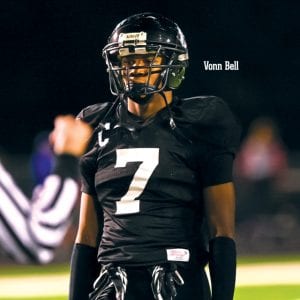
McCoy and Cooper served as a change of pace to Bridges and Bell, and Mariakis remembers that as a key factor in making this backfield great. “What made this backfield so special was that we had four great guys for three positions. If one needed a break, we had a quality back to go in. It definitely wasn’t a one man show,” he remarks. McCoy averaged 9.42 yards per carry and rushed for 5 touchdowns. Cooper rushed for 780 yards on 106 carries.







